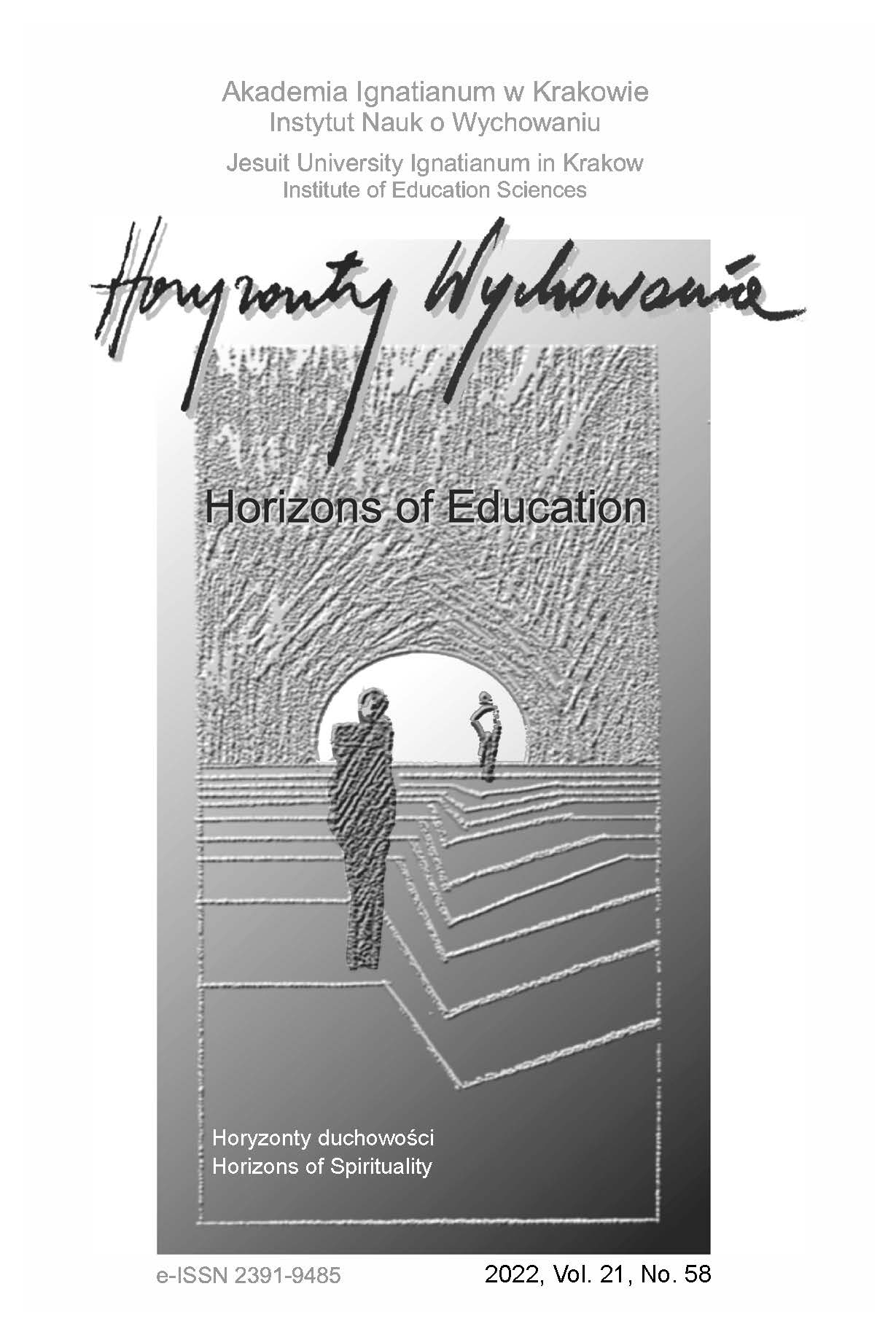Sermons and Homilies as the Tools of Shaping Children Spirituality: The Pragmalinguistic Aspects of the Communication Context
Abstract
RESEARCH OBIECTIVE: The aim of this article is to present some contextual conditioning of the sermons and homilies that are examined as a tool in the process of shaping the spirituality of children.
THE RESEARCH PROBLEM AND METHODS: The impact and the importance of the context in the sermons and homilies for children in the background of pragmalinguistics.
THE PROCESS OF ARGUMENTATION: First of all the linguistic aspects of human spirituality were presented. Then the sermons as a tool in the process of shaping the spirituality of children were described. The analysis of the material focused on the language and the style of the collected texts and a context as a key element of communication was examined.
RESEARCH RESULTS: The presented considerations lead to implications that the communicative effectiveness of homiletic messages is conditioned not only by the content of the message that is important, but, first of all, the pragmalinguistic relationship between the sender and the recipient, references to other text. Also, the behavior of interlocutors and their cultural conditions appears significant for it.
CONCLUSIONS, INNOVATIONS, AND RECOMMENDATIONS: The conclusions indicate primarily the overwhelming interpersonal of the preacher over the listener. It is reflected both in the selection of linguistic forms and in the extra-linguistic system of roles, as well. This combination has a serious impact on the effectiveness of the activities aimed at shaping the child’s spirituality.
References
Austin, J.L. (1962). How to do things with words. Oxford University Press.
Awdiejew, A. (1987). Pragmatyczne podstawy interpretacji wypowiedzeń. Wydawnictwo Uniwersytetu Jagiellońskiego.
Białek, E. (2006). Duchowość w psychosyntezie. W: A. Grzegorczyk, J. Sójka, R. Koschany (red.), Fenomen duchowości (s. 277-286). Wydawnictwo Naukowe Uniwersytetu Adama Mickiewicza.
Golka, M. (2008). Socjologia kultury. Wydawnictwo Naukowe „Scholar”.
Grice, P. (1975). Logic and conversation. W: P. Cole, J.L. Morgan (red.), Syntax and semantics, 3: Speech acts (s. 41-58). Academic Press.
Gruchoła, M. (2010). Kultura w ujęciu socjologicznym. Roczniki Kulturoznawcze, 1, 95-114.
Grzegorczykowa, R. (2006). Co o fenomenie duchowości mówi język? W:A. Grzegorczyk, J. Sójka, R. Koschany (red.), Fenomen duchowości (s. 21-28). Wydawnictwo Naukowe Uniwersytetu Adama Mickiewicza.
Kalisz, R. (1993). Pragmatyka językowa. Wydawnictwo Uniwersytetu Gdańskiego.
Kłoczowski, J.A. (2006). Czym jest duchowość? Kontekst religijny i kulturowy. W: A. Grzegorczyk, J. Sójka, R. Koschany (red.), Fenomen duchowości (s. 13-18). Wydawnictwo Naukowe Uniwersytetu Adama Mickiewicza.
Maldjieva, V. (2019). Językowe szaty duchowości. Wydawnictwo Naukowe Uniwersytetu Mikołaja Kopernika.
Nęcki, Z. (2000). Komunikacja międzyludzka. Wydawnictwo Antykwa.
Pisarkowa, K. (1975). Pragmatyczny składnik kompetencji językowej. Polonica, 1, 7-18.
Pisarkowa, K. (1976). Pragmatyczne spojrzenie na akt mowy. Polonica, 2, 265-279.
Rutkowska, I. (2020). Papież Franciszek o języku głoszenia Ewangelii. W: W. Przyczyna, K. Skowronek (red.) Język homilii i kazań (s. 27-40). Wydawnictwo Biblos.
Searle, J. (1969). Speech acts. Cambridge University Press.
Searle, J. (1975). Indirect speech acts. W: P. Cole, J.L. Morgan (red.), Syntax and semantics, 3: Speech acts (s. 59-82). Academic Press.
Searle, J. (1976). A classification of „illocutionary acts”. Language in Society, 5, 1-23.
Sieradzka-Mruk, A. (2003). Odbiorca jako czynnik kształtujący wypowiedź (na przykładzie kazań dla dzieci). Towarzystwo Wydawnicze „Historia Iagellonica”.
Siwek, G. (2006). Kazanie. W: R. Kamiński, W. Przygoda, M. Fijałkowski (red.), Leksykon teologii pastoralnej (s. 366). Towarzystwo Naukowe KUL.
Sławiński, H. (2020). Homiletyka współczesna. O języku kazań i homilii. W: W. Przyczyna, K. Skowronek (red.), Język homilii i kazań (s. 41-61). Wydawnictwo Biblos.
Uniwersalny słownik języka polskiego (2003). (S. Dubisz, red.). Wydawnictwo Naukowe PWN.
Wierzbicka, A. (1973). Akty mowy. W: M.R. Mayenowa (red.), Semiotyka i struktura tekstu (s. 125-137). Zakład Narodowy im. Ossolińskich.
Flis, G. (2020). Kazanie dla dzieci – Bóg na pierwszym miejscu. https://michalici.pl/artykul/kazanie-dla-dzieci-bog-na-pierwszym-miejscu
Maciejewski, P.Z. (2015a). Jak zostać królem? https://funawi.pl/jak-zostac-krolem/
Maciejewski, P.Z. (2015b). Nie bój się końca świata. https://funawi.pl/nie-boj-sie-konca-swiata/
Maciejewski, P.Z. (2015c). Pamiętaj, by kochać – kazanie o krzyżu. https://funawi.pl/pamietaj-by-kochac-kazanie-o-krzyzu/
Pikor, W. (2020). Być świadkiem Pana Jezusa. https://biblista.pl/ukryte/medytacje-biblijne/1500-niedziela-biblijna-iii-niedz-wielk-qbq-homilia-do-dzieci.html
Tomko, A. (1998). Kazanie dla dzieci pierwszokomunijnych „Niezapominajka”. https://bazhum. muzhp.pl/media/files/Wroclawski_Przeglad_Teologiczny
Zuber, D. (2010). Podobni do Jezusa (homilia dla dzieci). https://www.bkaznodziejska.pl
Zuber, D. (2011a). Co z nas wyrośnie? – kazanie dla dzieci. http://www.homopaschalis.pl/co-z-nas-wyrosnie/
Zuber, D. (2011b). Święty, czyli szczęśliwy. https://www.homopaschalis.pl/category/kazania-dla-dzieci/page/10/
Zuber, D. (2013). Jak zostać superbohaterem? – kazanie dla dzieci. http://www.homopaschalis.pl/
jak-zostac-superbohaterem/
Zuber, D. (2021). Z Jezusem zmieniamy świat na lepszy. http://www.homopaschalis.pl/
Copyright (c) 2022 HORIZONS OF EDUCATION

This work is licensed under a Creative Commons Attribution-NoDerivatives 4.0 International License.
Authors who publish in this journal agree to the following terms:
- Authors retain the copyright to their work while granting the journal the right of first publication. The work will be simultaneously licensed under a CC BY-ND license, which permits others to share the work with proper credit given to the author and the original publication in this journal.
- Authors may enter into additional, non-exclusive agreements for the distribution of the published version of the work (e.g., posting it in an institutional repository or publishing it in another journal), provided that the original publication in this journal is acknowledged.
We allow and encourage authors to share their work online (e.g., in institutional repositories or on personal websites) both before and during the submission process, as this can foster beneficial exchanges and lead to earlier and increased citations of the published work. (See The Effect of Open Access). We recommend using any of the following academic networking platforms:





